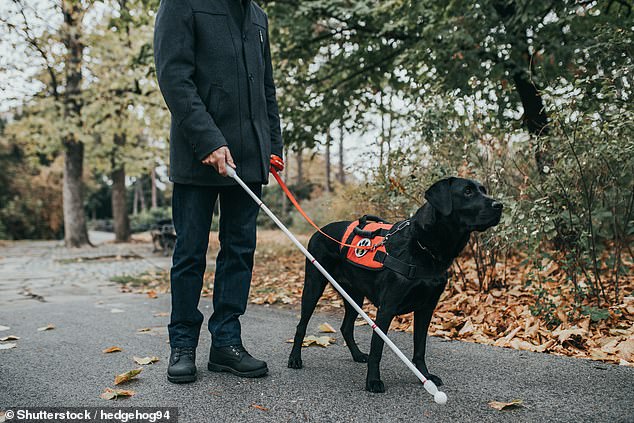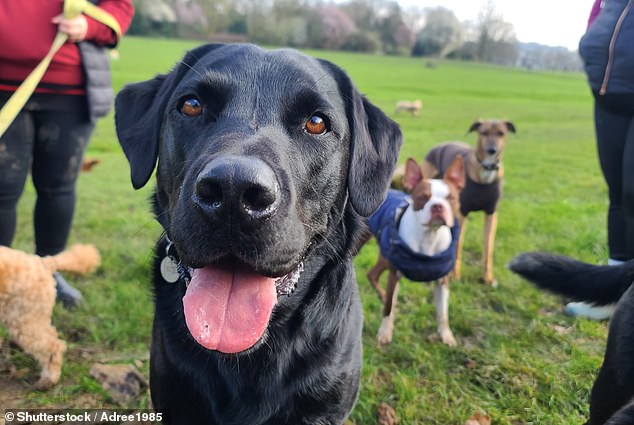Dogs might be experiencing a third wave of domestication due to people’s preference for companions that are amiable, tranquil, and adapted to an inactive lifestyle.
A few decades back, dogs were primarily viewed as working creatures, assigned roles like pest control, livestock management, and home protection.
But today, companionship holds far greater value priority for pet owners.
Scientists have found that this shift has increased levels of a hormone responsible for social bonding in dogs, and especially in service dogs.
A study concluded that the hormone – oxytocin – is what drives dogs to seek contact with their owners.
As wolves were domesticated into the loving companions we have today, researchers found that dogs developed an enhanced sensitivity to oxytocin.
The research, carried out by scientists from Linköping University in Sweden in 2017, explored how dogs acquired their distinctive capability of collaborating with humans, particularly focusing on their tendency to seek assistance when confronted with challenging tasks.
The researchers suspected that the hormone oxytocin was involved, as it is known to play a role in social relationships between individuals.
The impact of oxytocin relies on its ability to bind effectively with its receptor within cellular structures.
Prior research has demonstrated that differences in genetic material near the gene responsible for oxytocin receptors affect dogs’ communication abilities.
To put it differently, a dog’s ability to interact socially is partly rooted in their genetic makeup, particularly in the genes that regulate their response to oxytocin.
The scientists watched 60 golden retrievers try to raise the lid off a jar of treats, which had been deliberately designed to be unopenable.
They additionally gathered DNA samples from within the dogs’ nostrils to identify which variation of the oxytocin receptor gene each dog possessed.

The canines underwent this behavior assessment two times: first following an application of oxytocin nasal spray, and subsequently after using a neutral saline nasal spray.
The group measured how long the dogs would try to unscrew the jar on their own before looking towards their owners for assistance.
The results showed that dogs with a particular genetic variant of the receptor had a stronger reaction to the oxytocin spray than other dogs, and that the oxytocin dose made them more likely to ask for help than the saline dose.
These findings offer insight into how domestication has altered the genes that influence dogs’ social skills.
Currently, according to canine experts Brian Hare and Vanessa Woods, dogs’ behavioral characteristics are experiencing a third phase of domestication.
As the function of these creatures in our existence has evolved from being workers to becoming companions, their behaviors—and possibly even their biological traits—have also changed.
Hare is an evolutionary anthropology professor at Duke University and serves as the director of the Duke Canine Cognition Center. Woods oversees the center’s Puppy Kindergarten program, where puppies are trained to become service animals.
The Puppy Kindergarten acts as an extended study to evaluate how various training methods influence dogs’ behaviors and mental growth over time.
Woods and Hare have concluded from studying these puppies that service dogs are ‘particularly well-suited for life in the 21st century.’ They mentioned this in their writing. The Atlantic.
These dogs are ‘highly skilled experts’ capable of helping their owner with various duties, staying composed and silent when they’re off-duty, and possessing exceptionally amiable personalities.
Woods and Hare noted that ‘in contrast to typical pet dogs, service dogs often show an affinity for strangers, even when they are still puppies.’
‘And increasing friendliness seems to have changed these dogs’ biology, just as it did thousands of years ago,’ the researchers added.
These exceptionally skilled canines exemplify the qualities of the perfect four-legged friend. They integrate effortlessly into their owners’ lifestyles and into contemporary society.
Woods and Hare noted that service dogs integrate into the lives of their humans in a manner that numerous pet owners who are physically able desire for their own animals to do so as well.
Just a few decades back, dogs had a significantly different perception compared to now. These animals were primarily seen as workers assigned tasks such as hunting, herding, and protecting their territory and inhabitants—trained to stay vigilant and engaged.
Until the 1990s, dogs typically lived outdoors. In those times, before our current extensive urban development, they enjoyed ample room to wander and discover new areas.
“If your canine companion shared your bed, chances are high you’d awaken infested with ticks or fleas,” the researchers noted.

However, nowadays many dogs reside in crowded places, leading them to stay indoors significantly more often. Additionally, they encounter unknown canines and humans much more regularly.
This change has led to certain traits that once made dogs attractive to our forebears becoming counterproductive, according to Woods and Hare. For instance, ‘being wary of unfamiliar individuals and creatures could make it tougher to take a dog for a stroll in the community.’
‘Canines that exhibit higher levels of energy, excitability, fearfulness, or anxiety compared to their peers are at greater risk of being surrendered to animal shelters, where securing a new adoptive home can prove challenging,’ they noted.
Woods and Hare suggest that these emerging social pressures are prompting a third wave of canine domestication, with service dogs being considered the most advanced individuals within this evolving community.
The researchers noted, “Service dogs might appear similar to typical Labrador Retrievers; however, when contrasted with military working dogs or even regular household Labs, they seem nearly like a distinct breed.”
“The distinctions between Canine Companion dogs and pets illustrate just how significantly a group of dogs can evolve within as few as 50 years,” they noted.
The process of canine domestication occurred roughly between 40,000 and 14,000 years ago. This initial phase started during the time when humans were hunter-gatherers and frequently discarded food remnants at the edges of their campsites.
According to Woods and Hare, wolves that exploited this consistent and calorie-abundant food supply obtained an advantage for surviving. Consequently, across many generations, the creatures’ inclination towards humans supplanted their fear and hostility.
The second phase started following the Industrial Revolution. Throughout this period, the emerging middle class sought canines that reflected the sophistication and financial means of their proprietors.
This led Westerners to start breeding dogs with particular physical characteristics, which eventually resulted in the creation of about 200 dog breeds now acknowledged by the American Kennel Club, as noted by the researchers.
As we embark on a third phase of domestication, which emphasizes shaping dogs’ temperaments to suit today’s environment, Woods and Hare argue that people ought to actively participate in guiding this development.
‘To ensure the well-being of both dogs and their owners, it is essential for people to breed and train more canines similar to service animals, initiating a fresh phase of canine domestication that will assist them in adapting to the new world we have shaped,’ they penned.





